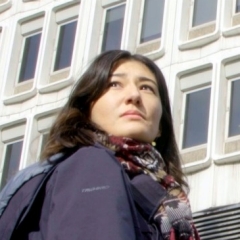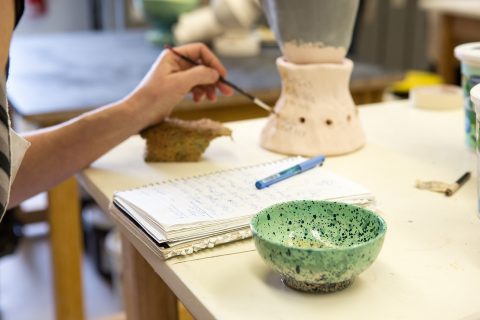Fibres and Material Practices (BFA)
Why study Fibres & Material Practices?
If you are interested in the technical and creative potential of the textile arts, then our program is a place for you to develop a personal voice in this dynamic form of expression. Drawing from a rich heritage of materials and processes, we encourage new ways of thinking. You'll consider current issues of sustainability, new technologies, labour and craft, along with experimental approaches and global and historical implications. You'll also imagine how material practice can be used to communicate your individual identity in contemporary culture.
Our professional facilities include a fibre structures studio for weaving, felt-making and basketry; a print and dye workshop; and a papermaking studio. As a student in this program, you'll benefit from:
- Small classes promoting personal expression and critical discussion
- An open and inclusive environment that encourages interdisciplinary approaches
- Freedom to pursue thematic and material interests
- Independent study at the advanced level
- Professional internships and other opportunities to enhance your technical expertise
You’ll leave our program with an expert combination of technical processes and the critical faculties of a contemporary artist.
Program highlights
- Interdisciplinarity is encouraged, as well as exploration of current issues such as sustainability, cultural representation, labour and craft, and new technologies.
- Applicants are not required to have experience with textile processes; introductory courses cover fundamental processes.
Special funding for out-of-province students
Up to $4000 for undergraduate programs.
Program structure
A Bachelor of Fine Arts degree takes a minimum of three or four years (90 – 120 credits) of full-time study, depending on your academic background.
Program option
- Major in Fibres and Material Practices (60 credits)
The Fibres and Material Practices program allows for a rigorous and comprehensive study of the technical, conceptual and creative aspects of current fibres practices. Students draw on diverse cultural or social research and a rich history of textile traditions to produce critically engaged artworks that use interdisciplinary, social, relational and performance elements.
Classes are small to promote personal expression and critical discussion and the open studio format supports the development of each student’s body of work. Students are introduced to a broad range of fibres structure processes and printing and dyeing techniques including:
- hand construction
- loom and off loom woven structures
- silk screen printing
- relief printing
- discharge and resist dyeing
- embellishment
- papermaking
At the intermediate level, you may choose from special topics courses that explore contemporary theoretical, critical, and practical issues. Independent study, professional internships, and advanced fibres courses will help you create a personal body of work as you refine technical expertise, and develop visual and critical concerns.
Courses
United States students: A U.S. Federal Student Aid-eligible version of this program is offered. This version meets all U.S. regulations (such as no co-operative education or e-courses) for eligible programs.
Admission criteria
This program is only available for Fall admission.
Minimum cut-off averages and course requirements
- Quebec CEGEP: DEC
- High School: C+
- ACT or SAT is NOT required
- Canadian curricula course requirements
- Accepted international qualifications
- International Baccalaureate (IB) diploma: 26
- International Baccalaureate Career-related Programme (CP): 26
- Baccalauréat français: 11
- British system of education (GCE):
- A-levels: At least two A-level exams CD or
- AS-levels: At least 4 AS-level exams with equivalent results or
- BTEC: Level 3 Diploma or Extended Diploma in a related subject area with equivalent results
- Additional information for British System of Education (GCE) applicants
- University Transfers (internal/external): C
Additional requirements for admission
Applicants must submit additional requirements for admission directly to the department.
- Letter of Intent
- Portfolio
Portfolio / Letter of intent
The portfolio of artwork for admission to a Studio Arts program should be a collection of your best and most recent work in visual arts. It should represent your individual interests, abilities and explorations. Consider visual, conceptual, and technical proficiency in selecting your best and most recent work.
If you are applying to more than one Fine Arts program, be sure to submit a separate portfolio for each program choice.
Your portfolio should contain:
- Minimum number of portfolio items: 15.
- Maximum number of portfolio items: 20.
- Each portfolio item must be a single digital file.
- Either recently completed or currently in progress.
- Include work that demonstrates your ability to work in a variety of media, in both two and three dimensions. Examples include drawings, paintings, prints, collage and other mixed media work, sculpture, ceramics, and fibres work.
- You may also include photographs, animation, film, video, audio recordings, and documentation of performance art.
- Please tailor your portfolio to the specific program area to which you are applying.
- Your work should show evidence of both technical skill and conceptual development. Basic abilities in drawing, composition and color-use must be demonstrated.
- You may not submit your portfolio via email or through other websites.
Letter of intent
Your letter of intent should be no longer than one page and written in English or French. In general, it should describe your educational background and any relevant experience in art, as well as your expectations in relation to the programs to which you are applying.
- What are your reasons for applying to this program? If you are particularly interested in an area within Studio Arts, please indicate why.
- Describe your educational background and any relevant experience.
- What are your goals and expectations in relation to this program?
Minimum cut-off averages should be used as indicators. The cut-off data may change depending on the applicant pool. Applicants who meet the stated minimum requirements are not guaranteed admission to these programs.
Application deadlines
It’s not too late to apply
Most undergraduate programs are still accepting applications for fall 2025.

FALL ENTRY (September)
Deadline: March 1
International applicants: Apply no later than February 1 to allow time for immigration document processing. However, applying earlier is strongly recommended. Immigration processing times vary by country, and delays could prevent you from starting your studies on time.

WINTER ENTRY (January)
Admission to this program is available for the Fall Term only.
We reserve the right to close admission to a program at any time after the official deadline without prior notice.
After your degree
You will graduate with the knowledge and discipline required for a creative and productive life. You’ll have creative problem-solving skills, know how to think critically about your work, and have the necessary leadership skills required for entrepreneurial endeavours. Your degree can lead to many paths such as:
- Graduate studies
- Practicing studio artist
- Art and design for artisanal or commercial production
Student story

Marilou Brickert
Bachelor of Fine Arts Major Design
Create and experiment with sustainable practices at the Faculty of Fine Arts, where Marilou Brickert brings artistic visions to life.
Other programs of interest

Clay offers endless creative possibilities. Throughout time, artists have been reinventing and renewing the art of ceramics.
Department
Faculty

Printmaking plants one foot in the past and the other firmly in the future
Department
Faculty

As a Studio Art major, you’ll have the flexibility to choose a concentration or combine any of our seven disciplines: Ceramics, Fibres and Material Practices, Intermedia/Cyberarts (Performance, Video, Electronic Arts), Painting and Drawing, Photography, Print Media, Sculpture and Installation.
Department
Faculty


